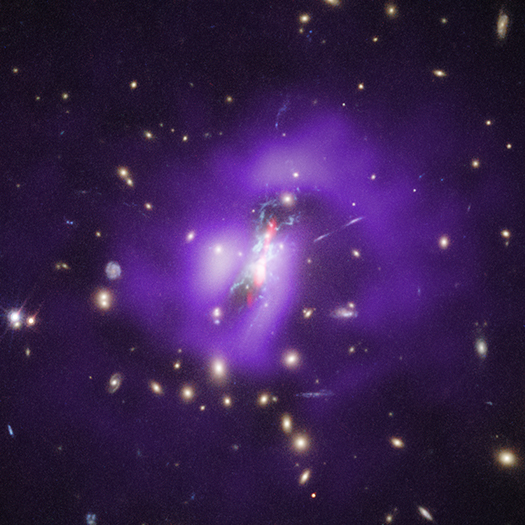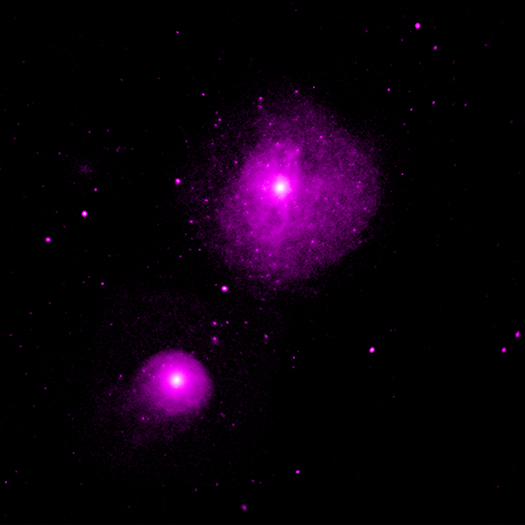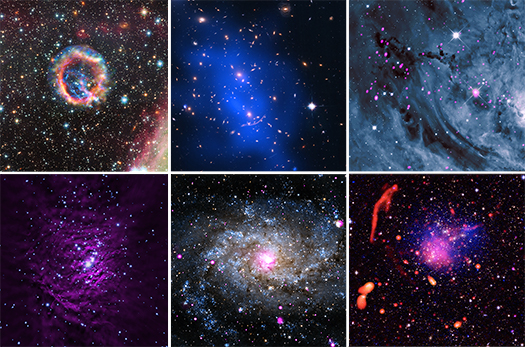Groups & Clusters of Galaxies
Excavating a Dinosaur in a Galaxy Cluster
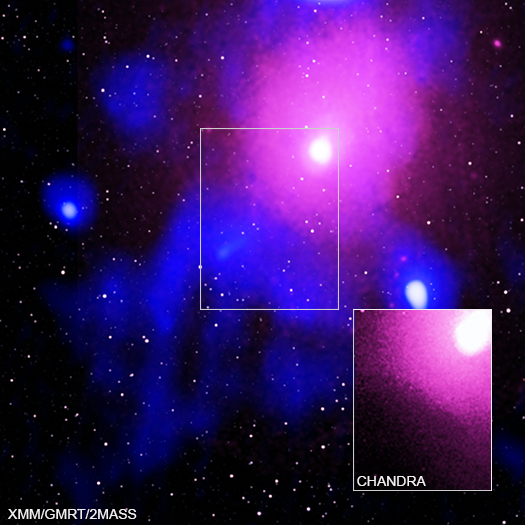
Ophiuchus Galaxy Cluster
Credit: X-ray: Chandra: NASA/CXC/NRL/S. Giacintucci, et al., XMM-Newton: ESA/XMM-Newton;
Radio: NCRA/TIFR/GMRT; Infrared: 2MASS/UMass/IPAC-Caltech/NASA/NSF
We are pleased to welcome two guest bloggers, Maxim Markevitch and Simona Giacintucci, who led the study described in our latest press release. Markevitch, an expert on galaxy clusters X-ray studies, got his PhD at the Space Research Institute of the Russian Academy of Sciences. He worked on ASCA X-ray data in Japan, then at the Chandra X-ray Center for the first 10 years of Chandra operations, and is now at the NASA Goddard Space Flight Center. He received the AAS Rossi Prize. Giacintucci, the lead author of the study, is an expert in radio phenomena in galaxy clusters. She got her PhD at Bologna University. She was a postdoc at the CfA and an Einstein fellow at the University of Maryland, and is now at the Naval Research Lab.
Galaxy clusters are colossal concentrations of dark matter, galaxies, and tenuous, 100-million-degree plasma. This plasma — gas where the electrons have been stripped from their atoms — slowly loses heat by emitting radiation in the form of X-rays. Around the central peaks of many clusters, where matter concentrates, the plasma gets dense enough* to cool quite fast, on a timescale shorter than the cluster's lifetime (a few billion years). The higher the plasma's density, the more X-rays it emits and the faster it cools. As it cools down, it contracts and becomes denser still, and so on, entering a runaway cooling process. Left unchecked, this process should deposit vast quantities of cold gas in the cluster centers.
We know for a fact that the plasma cools down because we do observe those X-rays — but we don't find nearly as much cold gas in the cluster centers as such runaway cooling must deposit. This has been a puzzle for a long while, and the solution the astronomers converged upon is that there must be some source of additional heat in the central regions of clusters — their “cores” — that doesn't let the plasma cool below 10 million degrees or so.
Early Chandra X-ray images of galaxy clusters pointed to the likely source: the supermassive black holes (SMBH) that sit in the centers of the cluster central galaxies, pull in the surrounding matter, and eject a tiny part of it (just before it sinks irretrievably into the black hole) at nearly the speed of light back into the surrounding gas. Where those jets hit the gas, they blow huge bubbles in it, stir it, generate shocks like sonic booms, etc. (all of these features have been seen in the Chandra images of the cluster cores). The current wisdom holds that these processes together supply the needed heat to prevent runaway cooling from occurring, but at the same time are not so powerful that they blow up the whole plasma cloud, implying some kind of a gentle, self-regulated feedback loop may be occurring.
Galaxy Gathering Brings Warmth
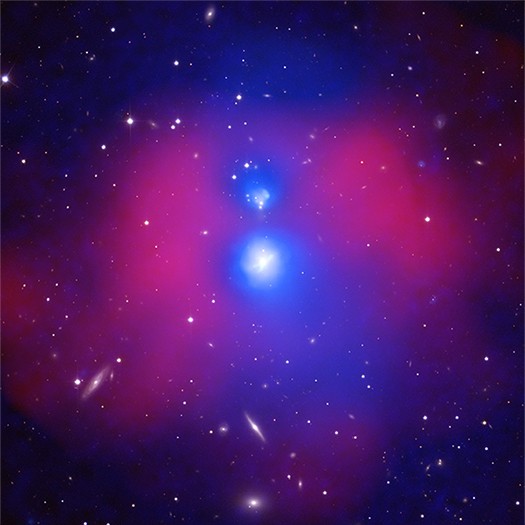
NGC 6338
Credit: X-ray: Chandra: NASA/CXC/SAO/E. O'Sullivan; XMM: ESA/XMM/E. O'Sullivan; Optical: SDSS
As the holiday season approaches, people in the northern hemisphere will gather indoors to stay warm. In keeping with the season, astronomers have studied two groups of galaxies that are rushing together and producing their own warmth.
The majority of galaxies do not exist in isolation. Rather, they are bound to other galaxies through gravity either in relatively small numbers known as "galaxy groups," or much larger concentrations called "galaxy clusters" consisting of hundreds or thousands of galaxies. Sometimes, these collections of galaxies are drawn toward one another by gravity and eventually merge.
Using NASA's Chandra X-ray Observatory, ESA's XMM-Newton, the Giant Metrewave Radio Telescope (GMRT), and optical observations with the Apache Point Observatory in New Mexico, a team of astronomers has found that two galaxy groups are smashing into each other at a remarkable speed of about 4 million miles per hour. This could be the most violent collision yet seen between two galaxy groups.
A Friendly Neighborhood Supermassive Black Hole

Roberto Gilli
We are very happy to welcome Roberto Gilli as our guest blogger. Dr. Gilli is the first author of a paper that is the subject of our latest Chandra press release. He received his Ph.D. in astronomy from Firenze University in Italy in 2001. Afterward, he did a post-doctoral fellowship at The Johns Hopkins Observatory before returning to Firenze at the Arcetri Astrophysical Observatory. Today, he is an astronomer at the National Institute of Astrophysics (INAF) in Bologna, Italy, a position he has held since 2005. His research interests include active galactic nuclei, quasars, and deep X-ray surveys.
Black holes are usually perceived as dangerous, disruptive systems. On the one hand they swallow copious amount of matter. On the other, they release a large amount of energy in the form of both radiation and matter when enormous quantities of material fall onto them.
The most extreme manifestation of such phenomenon is known as a "quasar" or an "active galactic nucleus" (AGN) that are powered by growing supermassive black holes (SMBHs) at galaxy centers. During these growth phases, part of the gravitational energy of the infalling gas is converted into strong electromagnetic radiation. Meanwhile, some of the gas, rather than being swallowed by the black hole, is instead accelerated and pushed very far away in the form of fast winds or even faster jets that can approach the speed of light.
A Weakened Black Hole Allows Its Galaxy to Awaken
The Phoenix galaxy cluster contains the first confirmed supermassive black hole that is unable to prevent large numbers of stars from forming in the core of the galaxy cluster where it resides. This result, reported in our latest press release, was made by combining data from NASA's Chandra X-ray Observatory and Hubble Space Telescope, and the NSF's Karl Jansky Very Large Array (VLA). A new composite image shows data from each telescope. X-rays from Chandra depict hot gas in purple and radio emission from the VLA features jets in red. Optical light data from Hubble show galaxies (in yellow), and filaments of cooler gas where stars are forming (in light blue).
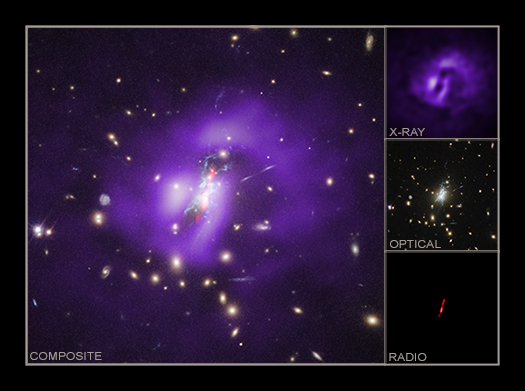
Witnessing the Formation of One of the Most Massive Objects in the Universe

Gerrit Schellenberger
We welcome Gerrit Schellenberger as our guest blogger. He received his PhD in Bonn, Germany in 2016, and has been a post-doctoral researcher at the Center for Astrophysics | Harvard & Smithsonian since March 2016. His research includes working on galaxy clusters and groups in large samples for cosmology, but also on individual objects in the X-rays and in the radio regime.
From the beginning of my astronomical career, I was fascinated by studying galaxy clusters, consisting of hundreds, sometimes even thousands of galaxies held together by gravity only. Yet, the galaxies alone do not — by far — sum up to the mass necessary to keep the cluster bound together. Beginning in the 1970s after the birth of X-ray astronomy and the first imaging satellites such as Einstein and ROSAT, scientists discovered that a very hot gas exists between the galaxies of the cluster. The mass of this gas exceeds the mass of all the stars in the galaxies together.
Although this gas is the most dominant, visible structure in galaxy clusters, it is only about 10% of the total mass (while the stars in the galaxies make only about 1%). The rest, roughly 90%, is dark matter, which cannot be observed directly. However, we can see its effect on the hot gas and galaxies in galaxy clusters: the gravity not only keeps the galaxies within the cluster, but also compresses the gas, heating it to the point where it emits X-rays. So we can study dark matter in clusters by measuring the properties (like temperature) of the hot gas from the X-ray emission.
Intrigued by this, I started to analyze a sample comprising 64 clusters during my PhD in Bonn, Germany, with the goal of obtaining total masses (including the dark matter component) for all of them. It turns out that smaller and lighter galaxy clusters, also called galaxy groups, do not follow the expected scaling between X-ray emission and temperature at a given cluster mass, meaning that the X-ray properties of gas in these systems cannot be used to give reliable mass estimates. Therefore, galaxy groups can only be of limited use for cosmological studies, where it is crucial to estimate the amount of matter in objects and how it changes with cosmic time.
Galaxy Clusters Caught in a First Kiss
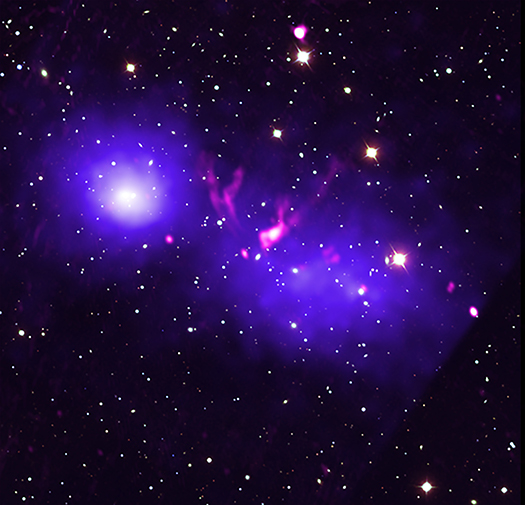
Cluster Merger
Credit: X-ray: NASA/CXC/RIKEN/L. Gu et al; Radio: NCRA/TIFR/GMRT; Optical: SDSS
For the first time, astronomers have found two giant clusters of galaxies that are just about to collide, as reported in a new press release by RIKEN. This observation is important in understanding the formation of structure in the Universe, sincelarge-scale structures—such as galaxies and clusters of galaxies—are thought to grow by collisions and mergers.
The composite image shows the separate galaxy clusters 1E2215 and 1E2216, located about 1.2 billion light years from Earth, captured as they enter a critical phase of merging. Chandra’s X-ray data (blue) have been combined with a radio image from the Giant Metrewave Radio Telescope in India (red). These images were then overlaid on an optical image from the Sloan Digital Sky Survey that shows galaxies and stars in the field of view.
Does the Gas in Galaxy Clusters Flow Like Honey?
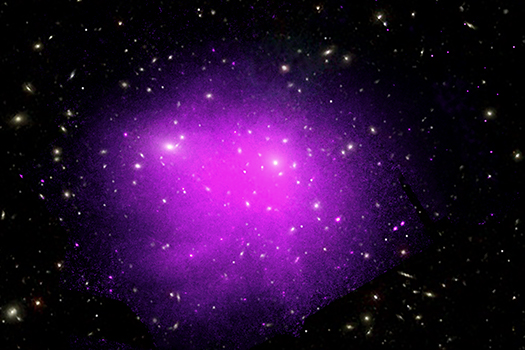
Coma Cluster
Credit: X-ray: NASA/CXC/Univ. of Chicago, I. Zhuravleva et al, Optical: SDSS
This image represents a deep dataset of the Coma galaxy cluster obtained by NASA's Chandra X-ray Observatory. Researchers have used these data to study how the hot gas in the cluster behaves, as reported in our press release. One intriguing and important aspect to study is how much viscosity, or "stickiness," the hot gas demonstrates in these cosmic giants.
Galaxy clusters are comprised of individual galaxies, hot gas, and dark matter. The hot gas in Coma glows in X-ray light observed by Chandra. Seen as the purple and pink colors in this new composite image, the hot gas contains about six times more mass than all of the combined galaxies in the cluster. The galaxies appear as white in the optical part of the composite image from the Sloan Digital Sky Survey. (The unusual shape of the X-ray emission in the lower right is caused by the edges of the Chandra detectors being visible.)
Chandra Finds Stellar Duos Banished from Galaxies
This image from NASA's Chandra X-ray Observatory shows the region around NGC 1399 and NGC 1404, two of the largest galaxies in the Fornax galaxy cluster. Located at a distance of about 60 million light years, Fornax is one of the closest galaxy clusters to Earth. This relative proximity allows astronomers to study the Fornax cluster in greater detail than most other galaxy clusters.
Chandra Serves up Cosmic Holiday Assortment
This is the season of celebrating, and the Chandra X-ray Center has prepared a platter of cosmic treats from NASA's Chandra X-ray Observatory to enjoy. This selection represents different types of objects — ranging from relatively nearby exploded stars to extremely distant and massive clusters of galaxies — that emit X-rays detected by Chandra. Each image in this collection blends Chandra data with other telescopes, creating a colorful medley of light from our Universe.
Cosmic Fountain Powered by Giant Black Hole
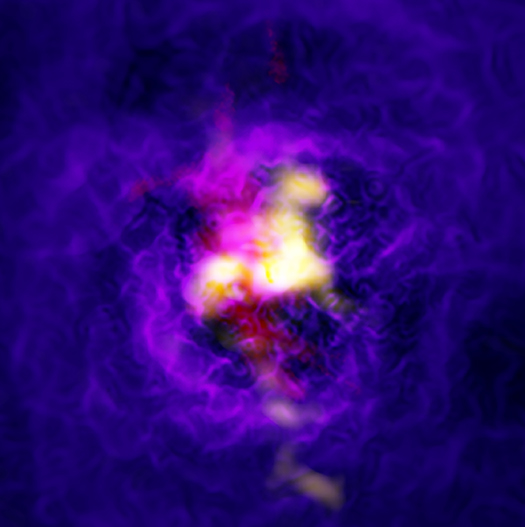
Abell 2597
Credit: X-ray: NASA/CXC/SAO/G. Tremblay et al; Radio:ALMA: ESO/NAOJ/NRAO/G.Tremblay et al, NRAO/AUI/NSF/B.Saxton; Optical: ESO/VLT
Before electrical power became available, water fountains worked by relying on gravity to channel water from a higher elevation to a lower one. This water could then be redirected to shoot out of the fountain and create a centerpiece for people to admire.
In space, awesome gaseous fountains have been discovered in the centers of galaxy clusters. One such fountain is in the cluster Abell 2597. There, vast amounts of gas fall toward a supermassive black hole, where a combination of gravitational and electromagnetic forces sprays most of the gas away from the black hole in an ongoing cycle lasting tens of millions of years.
Scientists used data from the Atacama Large Millimeter/submillimeter Array (ALMA), the Multi-Unit Spectroscopic Explorer (MUSE) on ESO's Very Large Telescope (VLT) and NASA's Chandra X-ray Observatory to find the first clear evidence for the simultaneous inward and outward flow of gas being driven by a supermassive black hole.

